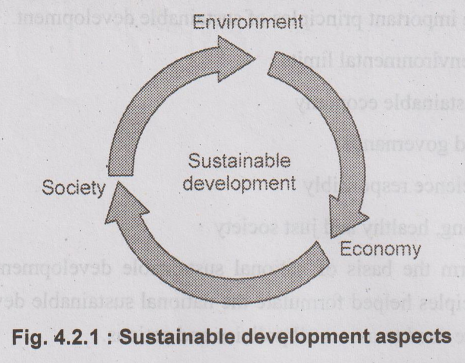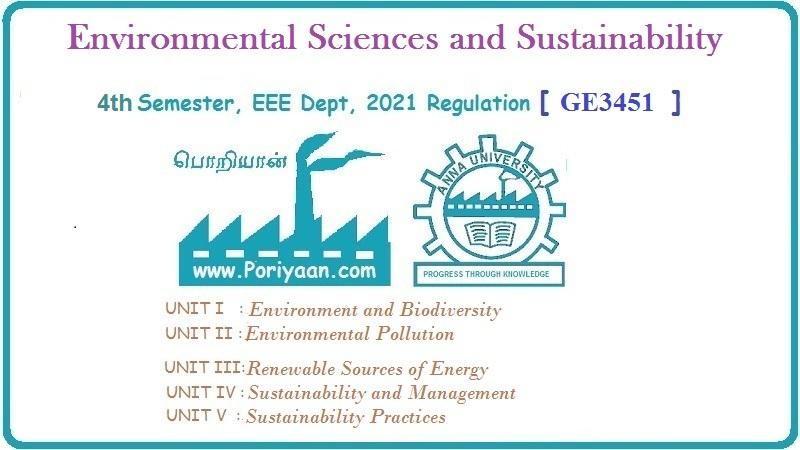Environmental Sciences and Sustainability: Unit IV: Sustainability and Management
Sustainable Development
Definition, Five Principles, Aspects, Agenda, Objectives, Factors Affecting, Threats
• Sustainable development is defined as development that meets the needs of the present without compromising the ability of the future generations to meet their own needs.
Sustainable Development
•
Sustainable development is defined as development that meets the needs of the
present without compromising the ability of the future generations to meet
their own needs.
•
Development means improving people's lives. Sustainable development means
extending progress without exhausting resources, beyond the future
requirements.
True
sustainable development
•
The true, sustainable development aims at optimum use of natural resources with
high degree of reusability, minimum wastage, least generation of toxic and
maximum productivity.
1. Five Principles of Sustainable Development
•
The principles of sustainable development involve safeguarding and using
existing resources in a sustainable way to enhance the long-term management of
and investment in, human, social and environmental resources, which is more
important than ever due to the evidence of diminishing natural resources and
the impacts of unsustainable development.
•
Following are five important principles of sustainable development.
1.
Living within environmental limits
2.
Achieving a sustainable economy
3.
Promoting good governance
4.
Using sound science responsibly
5.
Ensuring a strong, healthy and just society
•
The principles form the basis of national sustainable development strategies
and action plans. These principles helped formulate the national sustainable
development strategy and these principles are used to assess all policies and
actions.
•
In addition to the five agreed principles a sixth principle is now added : To
promote opportunity and innovation.
2. Sustainable Development Aspects
•
Three aspects of sustainable development are recognised as :
1.
Economic : An economically sustainable system must be able to
produce goods and services on a continuing basis, to maintain manageable levels
of government and external debt and to avoid extreme sectoral imbalances which
damage agricultural or industrial production.
2.
Environmental : An environmentally sustainable system
must maintain a stable resource base, avoiding over-exploitation of renewable
resource systems or environmental sink functions and depleting non-renewable
resources only to the extent that investment is made in adequate substitutes.
This includes maintenance of biodiversity, atmospheric stability and other
ecosystem functions not ordinarily classed as economic resources.
3.
Social : A socially sustainable system must achieve
distributional equity, adequate provision of social services including health
and education, gender equity and political accountability and participation.
Sustainable
Development Multidimensional Concept
•
Sustainable development is a multidimensional concept, which involves
continuous decision making of interlinked issues such as environment, social
community and economy. Fig. 4.2.1 shows important aspects of sustainable
development.

•
All the aspects are integrated and balanced without compromising the ability of
present and future generations to meet their needs.
•
Each of the three areas is commonly referred to as a system : Economic systems,
environmental systems and social systems each have their own logic. It. is an
impossible task to analyze all these systems at once.
•
Different indicators can be used to measure different dimensions of
sustaihability. Indicators imply measurement; measurement implies the
theoretical definition of concepts to measure.
3. Agenda for Sustainable Development
•
In 1992, Earth Summit was held at Rio de Janeiro of Brazil. A declaration of
the summit is - "a new and equitable global partnership through the
creation of new levels of co-operation among states."
•
Agenda 21 of the summit proposes - "sustainable
development starts from environmental policy. Social and economic equity are
the other requirements of sustainable development."
•
The important points of this agenda 21 are -
1.
Carrying capacity based developmental planning process.
2.
A preventive environmental policy.
3.
Structural economic change.
4.
The enlarged role of environmental management tools like -
*
Environmental Impact and Risk Assessment (EIRA),
*
Environmental Audit (EA),
*
Life Cycle Assessment (LCA),
*
Natural Resource Accounting (NRA).
4. Objectives of Sustainable Development
1.
To promote equity and fairness.
2.
To improve quality of human life.
3.
Sustaining of natural resources.
4.
Protecting ecosystem.
5.
To fulfill international obligations.
6.
Considering economic and environmental in decisions.
7.
To consider system as a whole.
8.
Long term planning and implementation.
5. Factors Affecting Sustainable Development
1.
Renewable and non-renewable resources.
2.
Population growth and population density.
3.
Gross Domestic Product (GDP) per capita.
4.
Consumption of energy and environmental resources.
5.
Pollution.
6.
Conservation / Use of land.
7.
Poverty gap index.
8.
Environmental awareness, education, literacy.
6. Threats to Sustainability
•
Various threats to sustainability are
1.
Resource depletion
3.
Loss of resilience
2.
Waste accumulation
4.
Loss of regionality
5.
Threats to biological diversity
6.
Threats to food chain
7.
Emerging diseases for animals
Review Question
1. Discuss the
recent approaches to achieve sustainable development.
AU : May-16, Marks
12
Environmental Sciences and Sustainability: Unit IV: Sustainability and Management : Tag: : Definition, Five Principles, Aspects, Agenda, Objectives, Factors Affecting, Threats - Sustainable Development
Related Topics
Related Subjects
Environmental Sciences and Sustainability
GE3451 ESS 4th Semester | 2021 Regulation | 4th Semester EEE Dept 2021 Regulation
